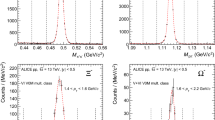Abstract
A large Hilbert space is used for the calculation of the nuclear matrix elements governing the light neutrino mass mediated mode of neutrinoless double beta decay (Ovββ-decay) of76 Ge,100 Mo,116 Cd,128 Te, and136 Xe within the proton-neutron quasiparticle random phase approximation (pn-QRPA) and the renormalized QRPA with proton-neutron pairing (full-RQRPA) methods. We have found that the nuclear matrix elements obtained with the standard pn-QRPA for several nuclear transitions are extremely sensitive to the renormalization of the particle-particle component of the residual interaction of the nuclear hamiltonian. Therefore the standard pn-QRPA does not guarantee the necessary accuracy to allow us to extract a reliable limit on the effective neutrino mass. This behavior already known from the calculation of the two-neutrino double beta decay matrix elements, manifests itself in the neutrinoless double-beta decay but only if a large model space is used. The full-RQRPA, which takes into account proton-neutron pairing and considers the Pauli principle in an approximate way, offers a stable solution in the physically acceptable region of the particle-particle strength. In this way more accurate values on the effective neutrino mass have been deduced from the experimental lower limits of the half-lifes of neutrinoless double beta decay.
Similar content being viewed by others
References
W. C. Haxton and G. S. Stephenson,Prog. Part. Nucl. Phys.,12 (1984).
M. G. Schepkin,Sov. Phys. Usp. 27, 555 (1984).
M. Doi, T. Kotani, and E. Takasugi,Prog. Theor. Phys. (Supp.),83, 1 (1985).
J. D. Vergados,Phys. Rep. 133, 1 (1986).
T. Tomoda,Rep. Prog. Phys. 54, 53 (1991).
A. Faessler, S. Kovalenko, F. Ŝimkovic, and J. Schwieger,Phys. Rev. Lett. 78, 183 (1997).
T. Tomoda and A. Faessler,Phys. Lett. B 199, 475 (1987).
J. Engel, P. Vogel, and M. R. Zirnbauer,Phys. Rev. C 37, 731 (1988).
K. Muto, E. Bender, and H. V. Klapdor,Z. Phys. A 334, 187 (1989).
G. Pantis, A. Faessler, W. A. Kaminski, and J. D. Vergados,J. Phys. G 18, 605 (1992).
F. Krmpotić and S. Sharma,Nucl. Phys. A 572, 329 (1994).
P. Vogel and M. R. Zirnbauer,Phys. Rev. Lett. 57, 3148 (1986).
O. Civitarese, A. Faessler, T. Tomoda,Phys. Lett. B 194, 11 (1987).
K. Muto, and H. V. Klapdor,Phys. Lett. B 201, 420 (1988).
J. Toivanen and J. Suhonen,Phys. Rev. Lett. 75, 410 (1995).
J. Schwieger, F. Ŝimkovic, and Amand Faessler,Nucl. Phys. A 600, 179 (1996).
F. Krmpotić, A. Mariano, E. J. V. de Passos, A. F. R. de Toledo Piza, and T. T. S. Kuo,Fizika B 5, 93 (1996).
J. G. Hirsch, P. O. Hess, and O. Civitarese,Phys. Rev. C 54, 1976 (1996).
J. G. Hirsch, P. O. Hess and O. Civitarese, nucl-th 9611008.
J. Engel, S. Pittel, M. Stoistov, P. Vogel, and J. Dukelsky, nucl-th/9610045.
F. Ŝimkovic, J. Schwieger, M. Veselsky, G. Pantis, and Amand Faessler,Phys. Lett. B. 393, 267 (1997).
M. K. Cheoun, A. Bobyk, A. Faessler, F. Ŝimkovic, and G. Teneva,Nucl Phys. A 561, 74 (1993); M. K. Cheoun, A. Bobyk, A. Faessler, F. Ŝimkovic, and G. Teneva,Nucl. Phys. A 564, 329 (1993); M. K. Cheoun, A. Faessler, F. Ŝimkovic, G. Teneva, and A. Bobyk,Nucl. Phys. A 587, 301 (1995).
G. Pantis, F. Ŝimkovic, J. D. Vergados, and Amand Faessler,Phys. Rev. C 53, 695 (1996).
K. Holinde,Phys. Rep. 68, 121 (1981).
P. Moeller and J. R. Nix,Nucl. Phys. A 536, 20 (1992).
R. G. Madland and J. R. Nix,Nucl. Phys. A 476, 1 (1988).
J. Engel, K. Langanke, and P. Vogel,Phys. Lett. B 389, 211 (1996).
M. Güntheret al. (Heidelberg-Moscow collaboration),Phys. Rev. D 55, 54 (1997).
M. Alston-Garnjostet al., Phys. Rev. Lett. 71, 831 (1993).
F. A. Danevichet al., Phys. Lett. B 344, 72 (1995).
T. Bernatowiczet al., Phys. Rev. Lett. 69, 2341 (1992).
J. C. Vuillemieret al., Phys. Rev. D, 1009 (1993).
Author information
Authors and Affiliations
Rights and permissions
About this article
Cite this article
Ŝimkovic, F., Schwieger, J., Pantis, G. et al. A large Hilbert space QRPA and RQRPA calculation of neutrinoless double beta decay. Found Phys 27, 1275–1289 (1997). https://doi.org/10.1007/BF02551528
Received:
Issue Date:
DOI: https://doi.org/10.1007/BF02551528




